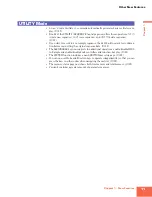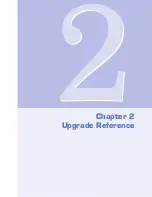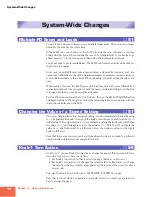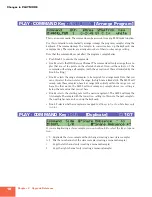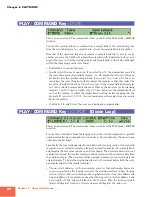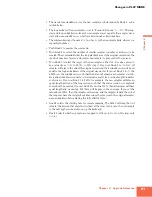
Changes in PLAY MODE
20
Chapter 2 Upgrade Reference
PLAY - COMMAND Key -
MOVE
This is a new command. The command can be accessed from the PLAY mode’s SAMPLE
function.
You use this command to move samples from a sample bank to the selected program,
from the selected program to a sample bank, or from one sample bank into another.
Note that if the operation targets any sample or sample bank that is also in use by
another program, the A3000 will replace these samples with “duplicates” before carry-
ing out the move (so that the original samples and sample banks will remain unchanged
within the other program that uses them).
• Push Knob 1 to execute the move.
• Knob 2 selects the type of operation. If you select
Pgm
→
, the command moves all of
the current program’s freestanding samples (i.e., all samples that are not within sam-
ple banks) into the specified sample bank. If you select
Pgm (Freeze)
→
, the com-
mand does the same thing but will also adjust the samples so that they reflect the
program’s Easy-Edit functions. If you choose
Pgm
←
, the command takes all samples
out of the selected sample bank and maps them to the program (as freestanding
samples).
Pgm
←
(Freeze)
is similar to
Pgm
←
, but in this case the command will set
each of the samples to reflect the sample bank’s settings before mapping into the
program. If you select
SB
→
SB
, the command moves all samples from one sample
bank into another.
• Use Knobs 3, 4, and 5 to set the source and destination sample banks.
PLAY - COMMAND Key -
LOOPDIV
[Divide Loop]
This is a new command. The command can be accessed from the PLAY mode’s SAMPLE
function.
You use this command to break the looping section of a selected sample into a specified
number of smaller pieces mapped to successive keys. You can then play the pieces in any
order from the keyboard.
Specifically, the command operates by reproducing the looping section of the selected
sample as a series of smaller samples, placing these smaller samples into a sample bank,
and mapping them to consecutive keys on the keyboard. The waveform data itself is not
reproduced; instead, the smaller samples continue to reference the waveform data from
the original sample. (The waveform will be retained in memory even if you delete the
original sample. To delete the original waveform itself, you must delete both the origi-
nal samples and all of the smaller samples.)
• The wave start addresses for the new samples are set so that each sample begins at a
successive part along the looping section of the original waveform (where “looping
section” refers to the section between the original waveform’s loop start address and
loop end address). For example, assume that the loop section starts at address 0 and
has a length of 1000, and you divide this into 10 pieces. Then the first new sample
(piece) will begin at location 0, the second piece will begin at 100, and so on.
Содержание A3000
Страница 1: ...Upgrade Guide for Version 2 1...
Страница 5: ...Chapter 1 New Features 1 1...
Страница 12: ...12 Chapter 1 New Features...
Страница 13: ...2 2 Chapter 2 Upgrade Reference...
Страница 41: ...A A Appendix...
Страница 50: ...804CRIT8 2 01A0 Printed in Japan V257250 M D G EMI Division Yamaha Corporation 1998...






